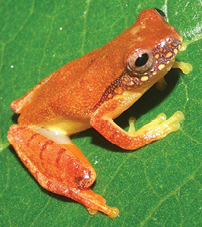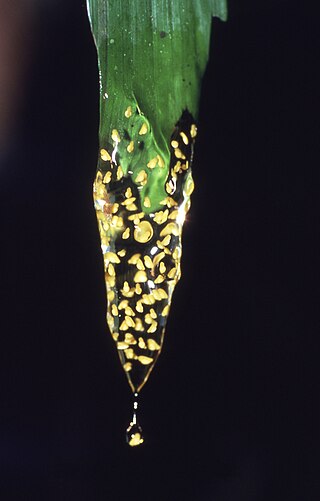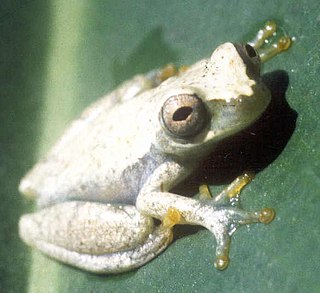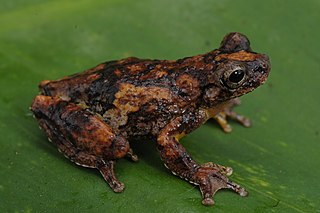Dendropsophus baileyi is a species of frog in the family Hylidae. It is endemic to Brazil. Its natural habitats are subtropical or tropical moist lowland forests, freshwater marshes, intermittent freshwater marshes, arable land, pastureland, plantations, rural gardens, urban areas, heavily degraded former forest, ponds, irrigated land, seasonally flooded agricultural land, and canals and ditches.

Dendropsophus bipunctatus is a species of frog in the family Hylidae. It is endemic to Brazil. Its natural habitats are subtropical or tropical moist lowland forests, subtropical or tropical moist montane forests, subtropical or tropical moist shrubland, subtropical or tropical seasonally wet or flooded lowland grassland, freshwater marshes, intermittent freshwater marshes, pastureland, and ponds.
Dendropsophus bokermanni is a species of frog in the family Hylidae. It is found in Brazil, Colombia, Ecuador, Peru, and possibly Bolivia. Its natural habitats are subtropical or tropical moist lowland forests, swamps, and intermittent freshwater marshes.

Dendropsophus brevifrons is a species of frog in the family Hylidae. It is found in Brazil, Colombia, Ecuador, French Guiana, Peru, and possibly Suriname. Its natural habitats are subtropical or tropical moist lowland forests, subtropical or tropical swamps, subtropical or tropical high-altitude grassland, intermittent freshwater marshes, pastureland, rural gardens, and urban areas. It is threatened by habitat loss.
Dendropsophus delarivai is a species of frogs in the family Hylidae.

Dendropsophus elegans is a species of frog in the family Hylidae. It is endemic to Brazil. Its natural habitats are subtropical or tropical moist lowland forests, subtropical or tropical moist shrubland, subtropical or tropical seasonally wet or flooded lowland grassland, freshwater marshes, intermittent freshwater marshes, pastureland, plantations, heavily degraded former forest, and ponds.

Dendropsophus luteoocellatus is a species of frog in the family Hylidae. It is endemic to Venezuela. Its natural habitats are subtropical or tropical moist lowland forests, subtropical or tropical moist montane forests, freshwater marshes, pastureland, rural gardens, heavily degraded former forest, urban sewer systems and ponds.
Dendropsophus melanargyreus is a species of mid-size tree frog in the family Hylidae. It is found in Bolivia, Brazil, French Guiana, Paraguay, and Suriname. Its natural habitats are subtropical or tropical dry forests, subtropical or tropical moist lowland forests, and intermittent freshwater marshes. It is threatened by habitat loss.

Dendropsophus microps is a species of frog in the family Hylidae. It is found in Brazil and possibly Argentina. Its natural habitats are subtropical or tropical moist lowland forests, subtropical or tropical moist montane forests, subtropical or tropical moist shrubland, intermittent freshwater marshes, plantations, heavily degraded former forest, ponds, and canals and ditches. It is threatened by habitat loss.
Dendropsophus minusculus is a species of frog in the family Hylidae. It is found in Colombia, French Guiana, Guyana, Suriname, Trinidad and Tobago, and Venezuela. Its natural habitats are subtropical or tropical moist lowland forests, dry savanna, moist savanna, subtropical or tropical seasonally wet or flooded lowland grassland, freshwater marshes, intermittent freshwater marshes, arable land, rural gardens, heavily degraded former forest, and ponds.

Dendropsophus minutus is a species of frog in the family Hylidae. It is found in Argentina, Bolivia, Brazil, Colombia, Ecuador, French Guiana, Guyana, Paraguay, Peru, Suriname, Trinidad and Tobago, Uruguay, and Venezuela. In Spanish it is known as ranita amarilla común.
Dendropsophus nahdereri is a species of frog in the family Hylidae. It is endemic to Brazil. Its natural habitats are subtropical or tropical moist lowland forests, freshwater marshes, intermittent freshwater marshes, rural gardens, heavily degraded former forest, ponds, and aquaculture ponds.
Dendropsophus pelidna is a species of frog in the family Hylidae. It is found in Colombia and Venezuela. Its natural habitats are subtropical or tropical moist montane forests, subtropical or tropical high-altitude shrubland, freshwater marshes, intermittent freshwater marshes, plantations, rural gardens, heavily degraded former forest, and ponds.
Dendropsophus praestans is a species of frog in the family Hylidae. It is endemic to Colombia. Its natural habitats are subtropical or tropical moist montane forests, freshwater marshes, intermittent freshwater marshes, arable land, pastureland, plantations, rural gardens, heavily degraded former forest, and ponds.
Dendropsophus pseudomeridianus is a species of frog in the family Hylidae. It is endemic to Brazil. Its natural habitats are moist savanna, subtropical or tropical seasonally wet or flooded lowland grassland, freshwater marshes, intermittent freshwater marshes, arable land, pastureland, plantations, rural gardens, heavily degraded former forest, ponds, and canals and ditches.

Dendropsophus seniculus is a species of frog in the family Hylidae. It is endemic to Brazil. Its natural habitats are subtropical or tropical moist lowland forests, swamps, freshwater marshes, intermittent freshwater marshes, and rural gardens. It is threatened by habitat loss.
Dendropsophus virolinensis is a species of frog in the family Hylidae. It is endemic to Colombia. Its natural habitats are subtropical or tropical seasonally wet or flooded lowland grassland, swamps, freshwater marshes, intermittent freshwater marshes, pastureland, and heavily degraded former forest.

Scinax alter, the Crubixa snouted treefrog, is a species of frog in the family Hylidae endemic to Brazil.

Triprion petasatus, Yucatán shovel-headed tree frog, Yucatan casque-headed tree frog, or Yucatan casquehead tree frog is a species of frog in the family Hylidae found in Belize, Guatemala, Honduras, and Mexico. Its natural habitats are subtropical or tropical dry forests, moist savanna, freshwater marshes, intermittent freshwater marshes, rural gardens, heavily degraded former forests, aquaculture ponds, and canals and ditches.

Polypedates leucomystax is a species in the shrub frog family Rhacophoridae. It is known under numerous common names, including common tree frog, four-lined tree frog, golden tree frog or striped tree frog. Many past authors have united it with the common Indian tree frog in P. maculatus, but today they are generally considered distinct species. In its native range, it is also called "white-lipped tree frog", but this name is otherwise applied to a species of true tree frogs.











